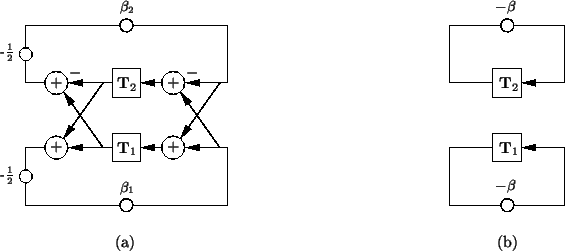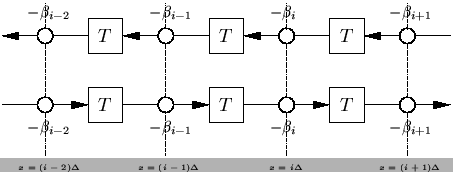


Next: The (2+1)D Parallel-plate System
Up: The (1+1)D Transmission Line
Previous: Energetic Interpretation
Simplified Networks
In the particular case for which  and
and  are constants, and where we do not have sources, the MDWD network shown in Figure 3.14(b) can be simplified considerably. If we pick
are constants, and where we do not have sources, the MDWD network shown in Figure 3.14(b) can be simplified considerably. If we pick
 and
and
 , then
, then  and
and  become zero, and their associated inductors may be dropped from the network (that is, they can be treated as short-circuits). The two series adaptors then reduce to simple multiplies of the signals output by the lattice two-port as in Figure 3.15(a) where we have written
become zero, and their associated inductors may be dropped from the network (that is, they can be treated as short-circuits). The two series adaptors then reduce to simple multiplies of the signals output by the lattice two-port as in Figure 3.15(a) where we have written
Figure 3.15:
Simplified MDWD network for the (1+1)D transmission line equations-- (a) for constant  and
and  and (b) further simplified in the distortionless case.
and (b) further simplified in the distortionless case.
 |
If, in addition, the transmission line is distortionless [28], so that we have  for all values of
for all values of  (though as mentioned above, we require
(though as mentioned above, we require  and
and  to be constant), then the network can be simplified further giving Figure 3.15(b), where
to be constant), then the network can be simplified further giving Figure 3.15(b), where
 . Now the MDWD network has decoupled into two independent loops, each comprised of an MD shift and a scaling. Examine the expanded signal flow graph of Figure 3.16, where the value of the multiplier coefficient
. Now the MDWD network has decoupled into two independent loops, each comprised of an MD shift and a scaling. Examine the expanded signal flow graph of Figure 3.16, where the value of the multiplier coefficient  at location
at location  is written as
is written as  . Values input into the upper array will be shifted repeatedly to the left and attenuated by the factor
. Values input into the upper array will be shifted repeatedly to the left and attenuated by the factor  , and similarly, those in the lower array are shifted to the right and attenuated by the same factor. We thus have a traveling wave formulation of the solution to the transmission line equations, to be compared with the digital waveguide implementation to be discussed in Chapter 4.
, and similarly, those in the lower array are shifted to the right and attenuated by the same factor. We thus have a traveling wave formulation of the solution to the transmission line equations, to be compared with the digital waveguide implementation to be discussed in Chapter 4.
Figure 3.16:
Signal flow graph for the MDWD network of Figure 3.15(b).
 |
Two special cases are of note here. If the transmission line is lossless, so that  , then
, then
 . The initial values in the storage registers are shifted without attenuation. We would like to note, however, that if
. The initial values in the storage registers are shifted without attenuation. We would like to note, however, that if
 , then
, then  , and the traveling waves will be oscillatory, and the solution is thus non-physical. More disturbing is the case
, and the traveling waves will be oscillatory, and the solution is thus non-physical. More disturbing is the case
 , in which case we have
, in which case we have  , and all energy leaves the network immediately! Though these examples would seem to indicate that the MDWD network is not behaving correctly, it should be kept in mind that, by construction, it is stable and consistent with the continuous time/space transmission line equations, and is convergent in the limit as
, and all energy leaves the network immediately! Though these examples would seem to indicate that the MDWD network is not behaving correctly, it should be kept in mind that, by construction, it is stable and consistent with the continuous time/space transmission line equations, and is convergent in the limit as
 , by the Lax-Richtmeyer Equivalence Theorem [176].
, by the Lax-Richtmeyer Equivalence Theorem [176].  can always be chosen small enough so that
can always be chosen small enough so that  is negative, and that thus the solution will be well-behaved (i.e., non-oscillatory). This important extra restriction on the grid spacing, which is independent of the time step, is purely a result of the use of the trapezoid rule as our integration method. The lesson here is that passivity, while providing a guarantee of stable numerical methods, does not ensure that we necessarily get a physically acceptable solution in all cases.
is negative, and that thus the solution will be well-behaved (i.e., non-oscillatory). This important extra restriction on the grid spacing, which is independent of the time step, is purely a result of the use of the trapezoid rule as our integration method. The lesson here is that passivity, while providing a guarantee of stable numerical methods, does not ensure that we necessarily get a physically acceptable solution in all cases.



Next: The (2+1)D Parallel-plate System
Up: The (1+1)D Transmission Line
Previous: Energetic Interpretation
Stefan Bilbao
2002-01-22



![]() for all values of
for all values of ![]() (though as mentioned above, we require
(though as mentioned above, we require ![]() and
and ![]() to be constant), then the network can be simplified further giving Figure 3.15(b), where
to be constant), then the network can be simplified further giving Figure 3.15(b), where
![]() . Now the MDWD network has decoupled into two independent loops, each comprised of an MD shift and a scaling. Examine the expanded signal flow graph of Figure 3.16, where the value of the multiplier coefficient
. Now the MDWD network has decoupled into two independent loops, each comprised of an MD shift and a scaling. Examine the expanded signal flow graph of Figure 3.16, where the value of the multiplier coefficient ![]() at location
at location ![]() is written as
is written as ![]() . Values input into the upper array will be shifted repeatedly to the left and attenuated by the factor
. Values input into the upper array will be shifted repeatedly to the left and attenuated by the factor ![]() , and similarly, those in the lower array are shifted to the right and attenuated by the same factor. We thus have a traveling wave formulation of the solution to the transmission line equations, to be compared with the digital waveguide implementation to be discussed in Chapter 4.
, and similarly, those in the lower array are shifted to the right and attenuated by the same factor. We thus have a traveling wave formulation of the solution to the transmission line equations, to be compared with the digital waveguide implementation to be discussed in Chapter 4.